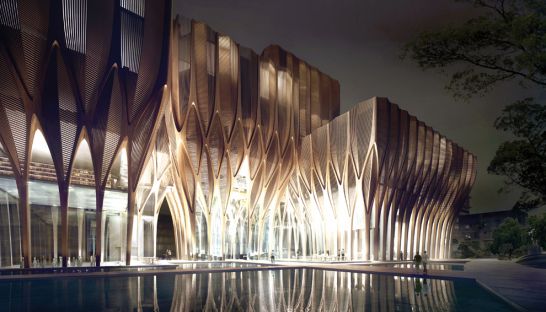The design of Cambodia’s much-anticipated genocide studies institute has been unveiled almost a year after the announcement that acclaimed architect Zaha Hadid would take the helm.
An artist’s impression of the Sleuk Rith Institute, expected to be completed within four years, shows a mammoth Angkor-inspired structure with interconnecting wooden buildings and reflecting pools.
“Zaha wished for a design that can shape the future and, to me, it is the Angkor Wat of the 21st century,” said Youk Chhang, the executive director of the Documentation Center of Cambodia (DC-Cam), which spearheaded the donor-funded project, the cost of which has not been finalised.
Built on the site of a Khmer Rouge re-education camp in Boeung Trabek, the Sleuk Rith Institute will incorporate a museum, research centre, graduate school, archives and research library. It will house the largest collection of genocide-related material in Southeast Asia.
The five wooden buildings, separate at the ground level, will connect through suspended bridges and passageways on the upper floors. A 68,000 square metre memorial park will flank the institute. The design bears climate in mind, with the buildings raised on terraces to protect against seasonal flooding and louvres installed to keep out strong sunshine with slanted shutters. Measures to reduce energy and water consumption will also be employed.
When asked why the design lacked the brutality of genocide memorials like Washington DC’s Holocaust Museum or the Jewish Museum in Berlin, Chhang said: “In the 21st century, you have to bring something hopeful for the country that has been devastated by war and genocide.”
Local architect Pagna Serey said he liked Hadid’s plans but would have preferred to see more of the 1960s brand of New Khmer architecture pioneered by Vann Molyvann incorporated.
“It is good to be inspired by Angkor period architecture, and it would be better to engage with New Khmer architecture also. It is good to be designed by one of the famous architects in the world and it would be best to involve Cambodian architects and artists,” he said.
Chhang said he chose a foreign architect because she would have more distance from the horrors of the regime. “We are so close to the crime that was committed against us. It is such a deep wound that it is hard for us to have distance,” he said, adding that 40 students from the Royal University of Fine Arts had also been consulted.
Iraq-born Hadid, who in 2004 received the Pritzker Architecture Prize, considered the Nobel of the field, has also designed the Guangzhou Opera House in China and the National Museum of the 21st Century Arts, or MAXXI, in Rome.
In a statement, Hadid said: “Our hope is that the Sleuk Rith institute and its Memorial Park can have a truly transformative effect, bringing new life and a bright future to a site that holds traces of the great tragedies of the past.”
Source: Phnom Penh Post

